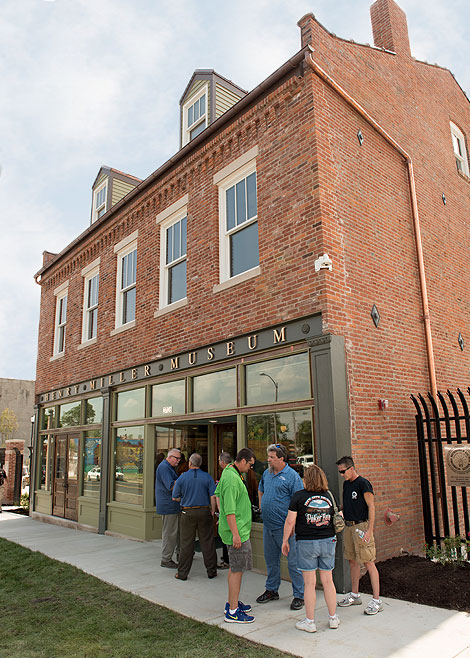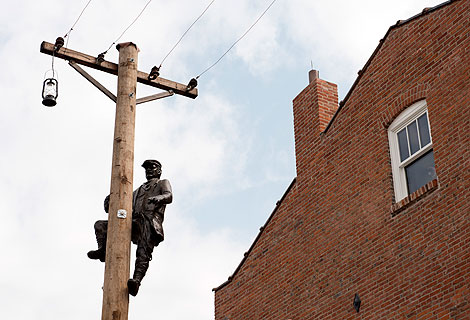39th International Convention Opens With Look at IBEW’s Past
September 19, 2016
On the opening day of the IBEW’s 39th International Convention in St. Louis, delegates and guests were treated to a trip through the Brotherhood’s 125-year history, starting with what we know of founding president Henry Miller and ending with this year’s careful restoration of the boardinghouse where he and his nine fellow delegates met in 1891.

|
| The Henry Miller Museum, located at 2726 Dr. Martin Luther King Dr. in St. Louis, hosted the first IBEW convention in 1891. It opened as a museum on Sept. 15.
|
The 5,000-strong crowd attending the convention were gathered less than a mile and a half from the modest structure where 10 men came together in November of 1891 to form the National Brotherhood of Electrical Workers.
“This story of our union’s founding right here in St. Louis is one we’re proud to tell to kick off this convention,” said International President Lonnie R. Stephenson. “By knowing where we came from and how we got to where we are, we put ourselves in a better position to prepare for the future.”
The origins of the NBEW started in the late 1880s when a young lineman named Henry Miller came to St. Louis and found work in the city’s grand Exposition Hall. There, he and a group of like-minded electricians decided they to band together to fight for better wages and working conditions.
And so, in 1890, the group met with an American Federation of Labor organizer to form the St. Louis Electrical Wiremen and Linemen’s Union Local 5221. But Miller wasn’t satisfied with a single local.
Throughout the next year, he traveled the country—often by boxcar—organizing local unions in Evansville, Ind., Louisville, Ky., Indianapolis, Chicago, Milwaukee, Toledo, Ohio, New Orleans, Pittsburgh, Cincinnati, Philadelphia and Duluth, Minn.
By September of 1891, Miller and his new brothers were ready to realize their dream of a national union of electrical workers, so they put out the call for delegates. On Nov. 21, T.J. Finnell from Chicago; F.J. Heizleman from Toledo; E.C. Hartung from Indianapolis; Harry Fisher from Evansville; Miller, J.T. Kelly and William Hedden from St. Louis; and J.C. Sutter, Joseph Berlovitz and James Dorsey representing locals by proxy, met on the second floor of the boardinghouse at 2726 Franklin Ave.
Over the next seven days, the 10 delegates hammered out the details of membership, including dues—10 cents a month—the original hand-drawn logo, and the election of officers. When the week concluded, Henry Miller was elected the NBEW’s first Grand President and Kelly was named its first Grand Secretary. On Dec. 4, the newly formed union was granted a charter with the A.F.L., granting it jurisdiction over all electrical work.
Sadly, Miller would not live to see the enormous success of the Brotherhood he helped to create. In 1896, while repairing storm damage in Washington, D.C., Miller was struck by a live wire and died that night.
Kelly would later write of his fallen Brother: "Every movement, whether revolutionary or peaceful, every organization established, no matter what the object, has associated with it the name of some individual whose mind conceived and whose energy and perseverance established it; and thus the name of Henry Miller will forever be associated with the organization of the Electrical Workers of America."

|
| One of 10 planned bronze lineman statues sits atop a utility pole in the museum’s adjacent Founders Park.
|
Preserving Our Legacy
In 2009, the International Office produced a video, part of which was featured on Monday, that located the Franklin Ave. boardinghouse. While the name of the street was changed to Martin Luther King Dr., the building was one of the only structures on the block that remained standing.
“When we first saw this place, we knew in our heart we had to save it,” St. Louis Local 1 Business Manager Frank Jacobs said. Over the next several years, Jacobs and Local 1 business representatives Dave Roth and John Kahrhoff set about the task of figuring out how to make it work.
When they purchased the building in November 2014, work began in earnest to get the museum finished in time for this week’s convention.
“We just made it,” said Local 1 journeyman wireman and project superintendent Dale Roth, who spent more than 10 months on the jobsite that concluded with the Sept. 15 ribbon-cutting. “I was here this morning sweeping floors and finishing things up,” he said of the busy hours before the first several hundred IBEW members and guests got their first look at the place.
Thanks to the ongoing generosity of hundreds of members and locals who have purchased commemorative coins, stone pavers, even entire floor sponsorships of the museum, the nonprofit Electrical Workers Historical Society hopes to fund the museum for many years to come. “We’re not there yet in terms of raising everything we need,” Stephenson said, “but we hope now that people are able to come and see this incredible place, we’ll be able to make sure it’s here for brothers and sisters in another 125 years.
"If it doesn't give you chills when you walk in there," Jacobs said, "there's something wrong with you."
Visit nbew-ibewmuseum.org to learn more about the museum. Also, visit the 'Donate' tab to contribute to the effort. Commemorative gifts are available at dozens of sponsorship levels, including bricks and pavers engraved with your name or your local's name in Founders Park.